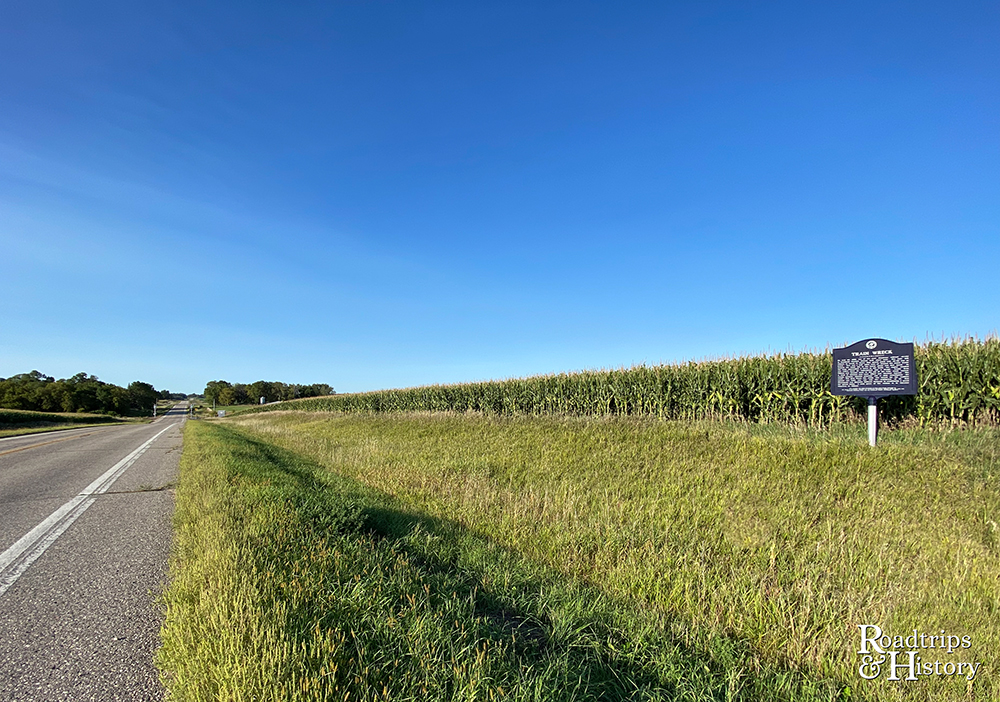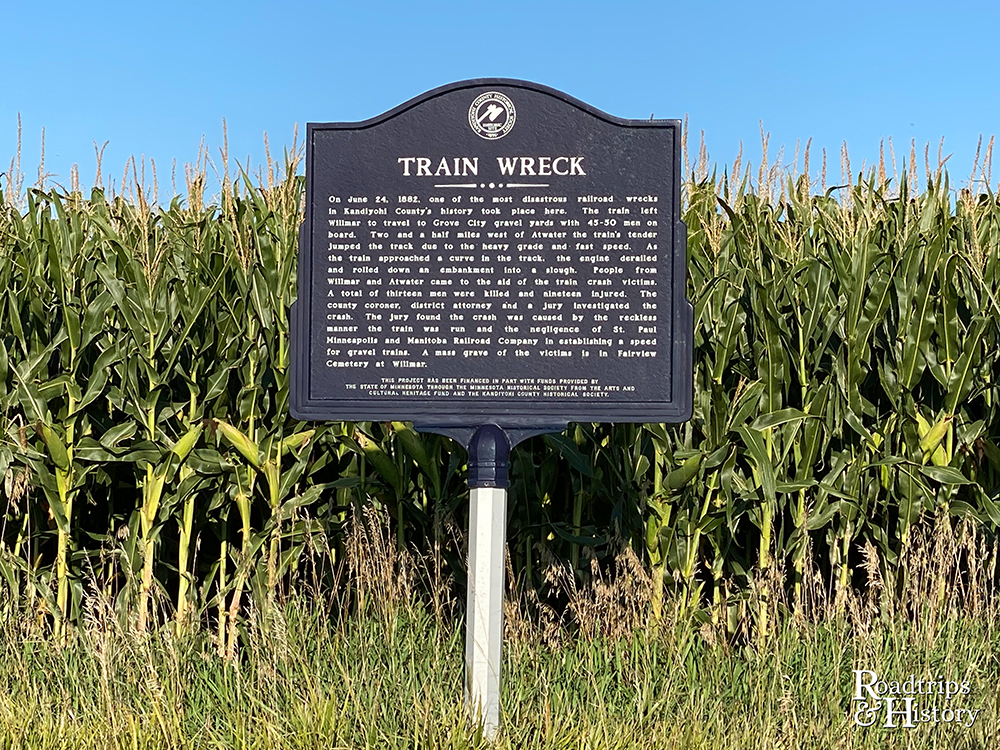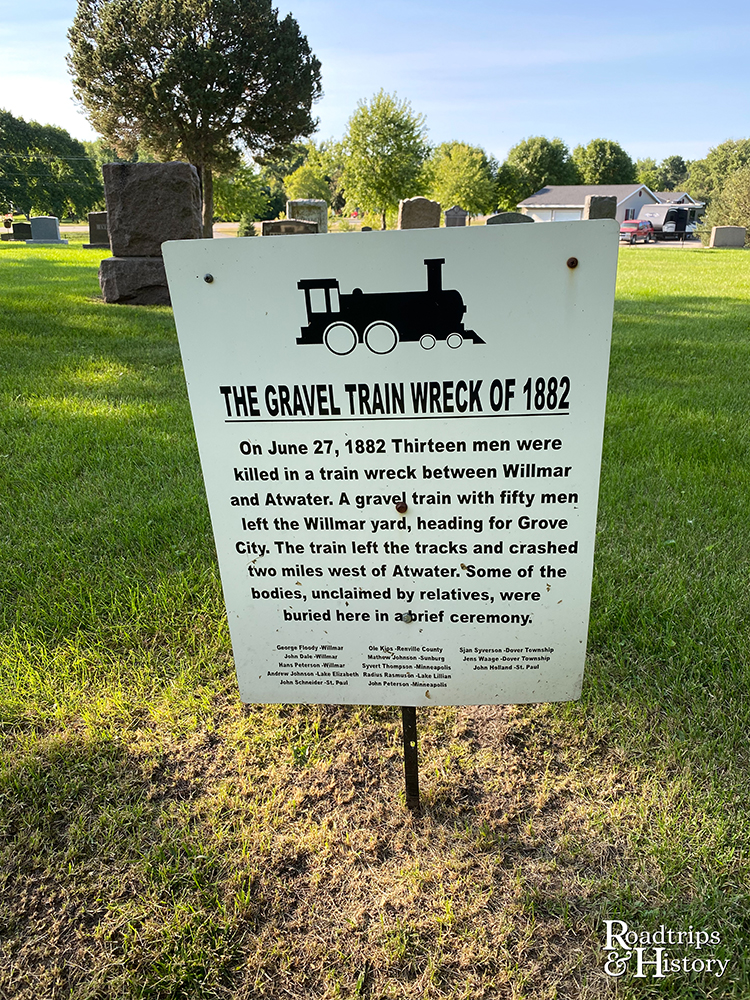On June 24, 1882, at around 3:00 p.m., St. Paul, Minneapolis and Manitoba Railroad Number 43 train was moving eastward from Willmar, Minnesota. The train was empty with a plan to pick up a load of gravel in Grove City. Since there was nowhere for the train to turn around, it moved in reverse on its way to Grove City and forward on the return trip to Willmar. Five crew members, including a conductor and engineer, and around 45 laborers were aboard the train. The laborers rode back and forth on the 19 flatbed cars attached to the engine and caboose. On this day, most of them were riding on the second flatbed from the engine.

An accident and the aftermath
Tragedy struck around 10 miles into the trip when the train was three miles west of Atwater. Reports show that the train had just come down a small hill and was on the flat when the engine, caboose, and 14 flatbed cars jumped the track and ended up in a large ditch filled with water. When the fog of the crash cleared, 13 men were dead, two others were seriously injured with severe burns, and five suffered minor injuries.
Among the dead was the train’s engineer and railroad veteran, George Floody. He’d been on the job with St. Paul, Minneapolis and Manitoba Railroad for three years. Floody had a stellar service record and was considered one of the company’s best employees. Meanwhile, conductor James Goran lived through the accident. He’d been with the company for two years after working at railroad companies back east for several years. Both men were indicted on third-degree manslaughter charges in Kandiyohi County. With Floody dead and the railroad vehemently denying any wrongdoing, Goran became the fall guy.

The coroner’s inquest
A coroner’s jury found the cause of the accident to be “the reckless manner in which the train was run” after hearing from several witnesses, reviewing operating procedures, and reading autopsy reports. It was established that the train was likely traveling 18-20 miles per hour — a typical speed for that run.
The jury believed that traveling downhill accelerated the train to the point it couldn’t be controlled and that neither Goran nor Floody noticed until it was too late. Therefore, St. Paul, Minneapolis and Manitoba Railroad were negligent for establishing a set speed for gravel trains and not making engineers and conductors responsible for watching and maintaining a safe speed while traveling downhill. The charges against Goran were dropped in 1883.
Several sensational stories made rounds through the county and among railroad workers. Some claimed the train was doing close to 50 miles per hour when it jumped the tracks. Others said that Goran pressured Floody to run the train as fast as possible so he could get home earlier. Some reported that Floody told the laborers that he would give them “the ride of their life” before departing Willmar. The coroner’s jury found all three of these rumors untrue, but that didn’t stop them from being told years and even decades later.

Their final resting place
Several of the dead were buried in a mass grave at Fairview Cemetery in Willmar. There is a small sign marking their final resting place with all of the train wreck victims listed: George Floody (Willmar), Andrew Johnson (Lake Elizabeth), Ole O. Kjas (Wang), Mathias Johnson (Sunberg), Syvert Thompson (Minneapolis), Rasmus Rasmussen (Lake Lillian), John Schneider (Saint Paul), Sjur Syverson (Dover Township), John Peterson (Minneapolis), Jens Jenson Waage (Dover Township), John Holland, John Dahl, Hans Jorgen Peterson (Willmar).
